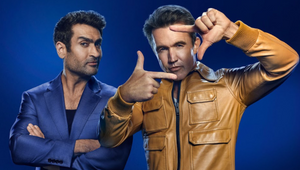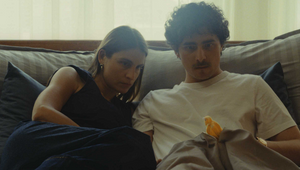
Unspoken Words: Audio, Algorithms and Art For Max

For his latest album, Unspoken Words, audio-visual artist Max Cooper has released a ground breaking immersive film project that explores the challenge of communication.
Having always struggled with words, Max taps into the power of music to bypass language as a form of universal expression. Unspoken Words leads the listener through experiences of escapism and connection to illuminate the experience of being human.
The music accompanies a visual story which unfolds through 13 short films by a range of visual artists, commissioned and directed by Max. Mixed in Dolby Atmos surround sound, Max collaborated with String and Tins for the spatial mixes, designed to be experienced interactively.
Here, musician Jon Bilbrough interviews Max Cooper and String and Tins sound designer Will Cohen to discuss the fascinating film project, and how science, philosophy and maths came together to craft this musical masterpiece.
Jon> Tell us a little bit about this project and the inspiration behind it.
Max> This is about what I can communicate with music and visuals that I can’t communicate with words. It turned into this visual story called Unspoken Words. The philosopher Ludwig Wittgenstein battled with expression - he did a lot of writing on the problems of words and language. We brought inspiration from his writing to some of the visuals using manipulated text and generated AI imagery.
I worked with a mathematician called Martin Krzywinski for the chapter ‘Transcendence’, which portrays dimensions continuously unfolding, taking us into this realm where we’re trying to escape the limitations of human expression.. He built a system that would start with one dimension growing to five dimensions of space by mapping the transcendental digits of Pi.
Jon> The team at String and Tins worked on the spatial mixes - what was that process like?
Will> Every engineer in the company worked on at least one mix for the project, led by myself, Max and his assistant Niels Orens. There was a lot of chat prior to any work being done, initially fuelled by a big mind splurge writeup from Max about what the visual analogues could be for the musical ideas. We theorised about what the spatial structures could be that relate to the concepts within each piece, and continued to refine / adapt these concepts depending on what felt right in the room.
A large proportion of people will be listening to the work on headphones, and some on the new Apple head tracking models - so we incorporated various binaural and immersive head tracking nuggets into the work that you can discover when listening through this medium. On the chapter ’Awakening’ for example, we created alternative stereo fields in the mix depending on which axis your head is aligned with when listening to the music - so rotating your listening position with head tracking headphones would unveil a different listening experience.
Jon> You write the music and then the visuals. Do you ever go back retrospectively and then cross pollinate?
Max> For the last three albums, I wrote the music first. But because of the circumstances that I wrote this album in, it was a little more flexible. But yes absolutely, there have been times when I've written music or had an idea and then started working with the visual artist and gone back to the music to bring the ideas together.
The music just makes a creative structure for what can be done that can always be rewritten as the project develops.
Jon> You use a lot of algorithms in your visuals, do you ever use them for music creation?
Max> I use a lot of partially generative processes but I wouldn’t say algorithms. A lot of my methodology involves sculpting - I'm a big fan of making a lot of material and then refining / chiselling it into a cohesive structure.
For example, I just love wiring together these LFOs with all sorts of things that shouldn't have LFOs on them, making a big mess and just jamming before I sculpt away all the bad bits to unveil something more coherent underneath.
Jon> How long did the project take from the early concept stage to the final?
Max> I created this in lockdown so this took a couple of years. A year of music, then six months for all the visuals; because every chapter was a collaboration with a different artist, it wasn’t all on one person’s plate. There’s a huge range of different styles across the chapters in the film, from hand drawn animation through to almost entirely generative work. I worked with a number of visual artists, deciding on those collaborations by matching their style with the concepts I wrote up.
Will> We started chatting about the potential of the work about four months before the visuals were finished. After those initial conversations on spatial theory, we started collating the parts for the tracks being exported by Niels, at times running to more than 70 stems so we could control minute details in the mix. We spent weeks working on the mixes, maximising the creative potential in Dolby Atmos collectively with Max and Niels. Once the mixes were signed off we created alternative masters for Blu-ray and DSP services such as Apple Music / Amazon / Tidal / Spotify.
It was a massive undertaking but we loved every minute of it - huge respect to Max and Niels, but also my colleagues Kaspar Broyd, Adam Smyth, Lawrence Kendrick, Culum Simpson, Mike Bamford, Joe Wilkinson, Adam Hare and Jim Stewart - you all smashed it :-)
Jon> Max, you have a PhD in computer science, does that play into your work a lot?
Max> I am drawn to art and music and I enjoy science and philosophy literature. I love chatting and collaborating with scientists and philosophers - it allows me to have a lot of stimulating conversation. I like to bounce ideas off other people and give them something to run with. When I collaborate I try not to restrict them too much.
Will> We definitely felt that when we worked with you. It was liberating to collaborate with someone so informed who was up for breaking rules.
Max> I love that, finding the boundaries and breaking them! It was awesome to be so experimental and toying with what can be done in the mix.















